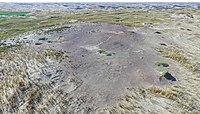Xichengyi culture: Difference between revisions
Appearance
Content deleted Content added
पाटलिपुत्र (talk | contribs) dot |
Citation bot (talk | contribs) Alter: doi. Add: s2cid, doi-access, bibcode. Removed proxy/dead URL that duplicated identifier. | Use this bot. Report bugs. | Suggested by Headbomb | #UCB_toolbar |
||
| Line 13: | Line 13: | ||
| precededby = [[Majiayao culture]] (3,300–2,000 BCE)<br> |
| precededby = [[Majiayao culture]] (3,300–2,000 BCE)<br> |
||
| followedby = [[Siba culture]] (1,600–1,300 BCE)<ref name="TAU">{{cite journal |last1=Li |first1=Xin |last2=Wei |first2=Wenyu |last3=Ma |first3=Minmin |last4=Lu |first4=Minxia |last5=Du |first5=Linyao |last6=Yang |first6=Yishi |last7=Chen |first7=Guoke |last8=Ren |first8=Lele |title=Transformation of animal utilization strategies from the late Neolithic to the Han Dynasty in the Hexi Corridor, northwest China: Zooarchaeological and stable isotopic evidence |journal=Frontiers in Earth Science |date=2023 |volume=10 |doi=10.3389/feart.2022.1064803 |
| followedby = [[Siba culture]] (1,600–1,300 BCE)<ref name="TAU">{{cite journal |last1=Li |first1=Xin |last2=Wei |first2=Wenyu |last3=Ma |first3=Minmin |last4=Lu |first4=Minxia |last5=Du |first5=Linyao |last6=Yang |first6=Yishi |last7=Chen |first7=Guoke |last8=Ren |first8=Lele |title=Transformation of animal utilization strategies from the late Neolithic to the Han Dynasty in the Hexi Corridor, northwest China: Zooarchaeological and stable isotopic evidence |journal=Frontiers in Earth Science |date=2023 |volume=10 |doi=10.3389/feart.2022.1064803 |bibcode=2023FrEaS..1064803L |issn=2296-6463 |doi-access=free }}</ref><br>[[Shajing culture]] (800–200 BCE)<ref name="TAU"/><br> |
||
[[Han Dynasty]] (202 BCE–220 CE)<ref name="TAU"/>}} |
[[Han Dynasty]] (202 BCE–220 CE)<ref name="TAU"/>}} |
||
[[File:Xichengyi sites.png|thumb|300px|Xichengyi sites (red)]] |
[[File:Xichengyi sites.png|thumb|300px|Xichengyi sites (red)]] |
||
The '''Xichengyi culture''' (Ch:西城驿文化) was an ancient culture in the central [[Heihe River]] region of the [[Hexi corridor]], from 2,000 to 1,600 BCE.<ref name="QM">{{cite journal |last1=Qiu |first1=Menghan |last2=Li |first2=Haoran |last3=Lu |first3=Minxia |last4=Yang |first4=Yishi |last5=Zhang |first5=Shanjia |last6=Li |first6=Ruo |last7=Chen |first7=Guoke |last8=Ren |first8=Lele |title=Diversification in Feeding Pattern of Livestock in Early Bronze Age Northwestern China |journal=Frontiers in Ecology and Evolution |date=2022 |volume=10 |doi=10.3389/fevo.2022.908131 |
The '''Xichengyi culture''' (Ch:西城驿文化) was an ancient culture in the central [[Heihe River]] region of the [[Hexi corridor]], from 2,000 to 1,600 BCE.<ref name="QM">{{cite journal |last1=Qiu |first1=Menghan |last2=Li |first2=Haoran |last3=Lu |first3=Minxia |last4=Yang |first4=Yishi |last5=Zhang |first5=Shanjia |last6=Li |first6=Ruo |last7=Chen |first7=Guoke |last8=Ren |first8=Lele |title=Diversification in Feeding Pattern of Livestock in Early Bronze Age Northwestern China |journal=Frontiers in Ecology and Evolution |date=2022 |volume=10 |doi=10.3389/fevo.2022.908131 |issn=2296-701X |doi-access=free }}</ref> It is contemporary with the [[Qijia culture]] to its southeast. It succeeded the [[Majiayao culture]] (2,300–2,000 BCE) in the area, and preceded the [[Siba culture]].<ref name="TAU"/> |
||
Some of its important archaeological sites are Xichengyi, Ganggangwa (where there are also some earlier [[Machang culture]] remains), and Huoshiliang (exclusively Xichengyi culture).<ref name="QM"/> |
Some of its important archaeological sites are Xichengyi, Ganggangwa (where there are also some earlier [[Machang culture]] remains), and Huoshiliang (exclusively Xichengyi culture).<ref name="QM"/> |
||
The Xichengyi culture practiced bronze smelting extensively, as seen by the quantity of slabs and furnace material (adobe constructions with blast pipes).<ref name="GC">{{cite journal |last1=Chen |first1=G. |last2=Cui |first2=Y. |last3=Liu |first3=R. |last4=Wang |first4=H. |last5=Yang |first5=Y. |last6=Pollard |first6=A. M. |last7=Li |first7=Y. |title=Lead isotopic analyses of copper ores in the Early Bronze Age central Hexi Corridor, north‐west China |journal=Archaeometry |date=October 2020 |volume=62 |issue=5 |pages=952–964 |doi=10.1111/arcm.12566 |url=https://pure.mpg.de/rest/items/item_3220150/component/file_3236602/content}}</ref> The copper ore was from the neighbouring [[:zh:甘肃北山|Beishan Mountain]].<ref name="GC"/> |
The Xichengyi culture practiced bronze smelting extensively, as seen by the quantity of slabs and furnace material (adobe constructions with blast pipes).<ref name="GC">{{cite journal |last1=Chen |first1=G. |last2=Cui |first2=Y. |last3=Liu |first3=R. |last4=Wang |first4=H. |last5=Yang |first5=Y. |last6=Pollard |first6=A. M. |last7=Li |first7=Y. |title=Lead isotopic analyses of copper ores in the Early Bronze Age central Hexi Corridor, north‐west China |journal=Archaeometry |date=October 2020 |volume=62 |issue=5 |pages=952–964 |doi=10.1111/arcm.12566 |s2cid=216443994 |url=https://pure.mpg.de/rest/items/item_3220150/component/file_3236602/content}}</ref> The copper ore was from the neighbouring [[:zh:甘肃北山|Beishan Mountain]].<ref name="GC"/> |
||
<gallery widths="200px" heights="130px" perrow="4"> |
<gallery widths="200px" heights="130px" perrow="4"> |
||
Revision as of 21:50, 26 November 2023
| Geographical range | Gansu, China |
|---|---|
| Dates | 2,000-1,600 BCE |
| Major sites | Xichengyi, Ganggangwa, Huoshiliang |
| Preceded by | Majiayao culture (3,300–2,000 BCE) |
| Followed by | Siba culture (1,600–1,300 BCE)[1] Shajing culture (800–200 BCE)[1] Han Dynasty (202 BCE–220 CE)[1] |

The Xichengyi culture (Ch:西城驿文化) was an ancient culture in the central Heihe River region of the Hexi corridor, from 2,000 to 1,600 BCE.[2] It is contemporary with the Qijia culture to its southeast. It succeeded the Majiayao culture (2,300–2,000 BCE) in the area, and preceded the Siba culture.[1]
Some of its important archaeological sites are Xichengyi, Ganggangwa (where there are also some earlier Machang culture remains), and Huoshiliang (exclusively Xichengyi culture).[2]
The Xichengyi culture practiced bronze smelting extensively, as seen by the quantity of slabs and furnace material (adobe constructions with blast pipes).[3] The copper ore was from the neighbouring Beishan Mountain.[3]
-
Huoshiliang site, EBA 2000-1600 BCE
-
Huoshiliang bronze slabs, 2000-1600 BCE
-
Huoshiliang pottery shards, Xichenyi culture, 2000-1600 BCE
-
Ganggangwa site
-
Ganggangwa site pottery shards, Xichengyi culture, 2000-1600 BCE
-
Xichengyi adobe building and bronze slabs.[3]
-
Xichengyi blast pipes.[3]
References
- ^ a b c d Li, Xin; Wei, Wenyu; Ma, Minmin; Lu, Minxia; Du, Linyao; Yang, Yishi; Chen, Guoke; Ren, Lele (2023). "Transformation of animal utilization strategies from the late Neolithic to the Han Dynasty in the Hexi Corridor, northwest China: Zooarchaeological and stable isotopic evidence". Frontiers in Earth Science. 10. Bibcode:2023FrEaS..1064803L. doi:10.3389/feart.2022.1064803. ISSN 2296-6463.
- ^ a b Qiu, Menghan; Li, Haoran; Lu, Minxia; Yang, Yishi; Zhang, Shanjia; Li, Ruo; Chen, Guoke; Ren, Lele (2022). "Diversification in Feeding Pattern of Livestock in Early Bronze Age Northwestern China". Frontiers in Ecology and Evolution. 10. doi:10.3389/fevo.2022.908131. ISSN 2296-701X.
- ^ a b c d Chen, G.; Cui, Y.; Liu, R.; Wang, H.; Yang, Y.; Pollard, A. M.; Li, Y. (October 2020). "Lead isotopic analyses of copper ores in the Early Bronze Age central Hexi Corridor, north‐west China". Archaeometry. 62 (5): 952–964. doi:10.1111/arcm.12566. S2CID 216443994.







![Xichengyi adobe building and bronze slabs.[3]](http://upload.wikimedia.org/wikipedia/commons/thumb/6/65/Xichengyi_adobe_building_and_bronze_slabs.png/200px-Xichengyi_adobe_building_and_bronze_slabs.png)
![Xichengyi blast pipes.[3]](http://upload.wikimedia.org/wikipedia/commons/thumb/c/ce/Xichengyi_blast_pipes.png/200px-Xichengyi_blast_pipes.png)